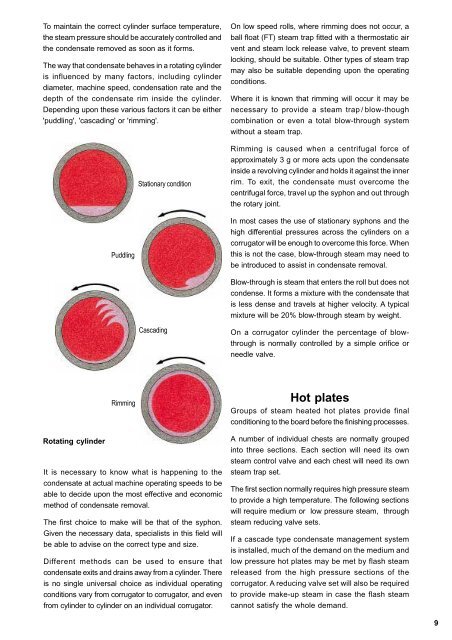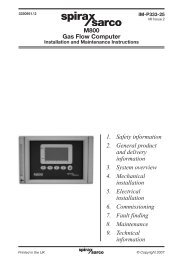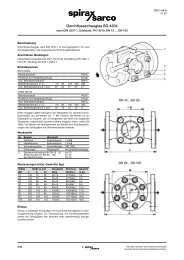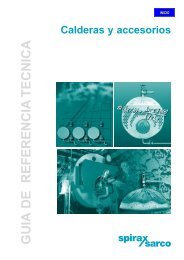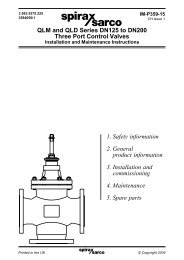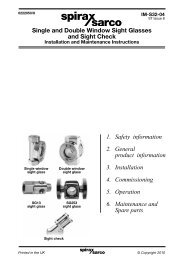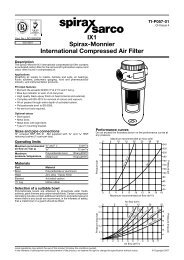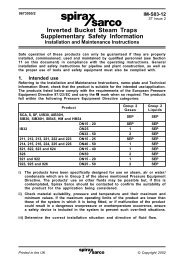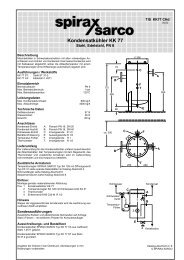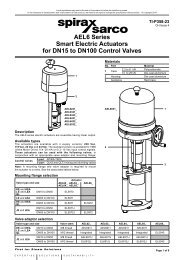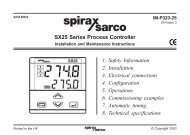The Corrugating Industry Steam and Condensate ... - Spirax Sarco
The Corrugating Industry Steam and Condensate ... - Spirax Sarco
The Corrugating Industry Steam and Condensate ... - Spirax Sarco
Create successful ePaper yourself
Turn your PDF publications into a flip-book with our unique Google optimized e-Paper software.
To maintain the correct cylinder surface temperature,<br />
the steam pressure should be accurately controlled <strong>and</strong><br />
the condensate removed as soon as it forms.<br />
<strong>The</strong> way that condensate behaves in a rotating cylinder<br />
is influenced by many factors, including cylinder<br />
diameter, machine speed, condensation rate <strong>and</strong> the<br />
depth of the condensate rim inside the cylinder.<br />
Depending upon these various factors it can be either<br />
'puddling', 'cascading' or 'rimming'.<br />
Puddling<br />
Stationary condition<br />
On low speed rolls, where rimming does not occur, a<br />
ball float (FT) steam trap fitted with a thermostatic air<br />
vent <strong>and</strong> steam lock release valve, to prevent steam<br />
locking, should be suitable. Other types of steam trap<br />
may also be suitable depending upon the operating<br />
conditions.<br />
Where it is known that rimming will occur it may be<br />
necessary to provide a steam trap / blow-though<br />
combination or even a total blow-through system<br />
without a steam trap.<br />
Rimming is caused when a centrifugal force of<br />
approximately 3 g or more acts upon the condensate<br />
inside a revolving cylinder <strong>and</strong> holds it against the inner<br />
rim. To exit, the condensate must overcome the<br />
centrifugal force, travel up the syphon <strong>and</strong> out through<br />
the rotary joint.<br />
In most cases the use of stationary syphons <strong>and</strong> the<br />
high differential pressures across the cylinders on a<br />
corrugator will be enough to overcome this force. When<br />
this is not the case, blow-through steam may need to<br />
be introduced to assist in condensate removal.<br />
Blow-through is steam that enters the roll but does not<br />
condense. It forms a mixture with the condensate that<br />
is less dense <strong>and</strong> travels at higher velocity. A typical<br />
mixture will be 20% blow-through steam by weight.<br />
Cascading<br />
On a corrugator cylinder the percentage of blowthrough<br />
is normally controlled by a simple orifice or<br />
needle valve.<br />
Rotating cylinder<br />
Rimming<br />
It is necessary to know what is happening to the<br />
condensate at actual machine operating speeds to be<br />
able to decide upon the most effective <strong>and</strong> economic<br />
method of condensate removal.<br />
<strong>The</strong> first choice to make will be that of the syphon.<br />
Given the necessary data, specialists in this field will<br />
be able to advise on the correct type <strong>and</strong> size.<br />
Different methods can be used to ensure that<br />
condensate exits <strong>and</strong> drains away from a cylinder. <strong>The</strong>re<br />
is no single universal choice as individual operating<br />
conditions vary from corrugator to corrugator, <strong>and</strong> even<br />
from cylinder to cylinder on an individual corrugator.<br />
Hot plates<br />
Groups of steam heated hot plates provide final<br />
conditioning to the board before the finishing processes.<br />
A number of individual chests are normally grouped<br />
into three sections. Each section will need its own<br />
steam control valve <strong>and</strong> each chest will need its own<br />
steam trap set.<br />
<strong>The</strong> first section normally requires high pressure steam<br />
to provide a high temperature. <strong>The</strong> following sections<br />
will require medium or low pressure steam, through<br />
steam reducing valve sets.<br />
If a cascade type condensate management system<br />
is installed, much of the dem<strong>and</strong> on the medium <strong>and</strong><br />
low pressure hot plates may be met by flash steam<br />
released from the high pressure sections of the<br />
corrugator. A reducing valve set will also be required<br />
to provide make-up steam in case the flash steam<br />
cannot satisfy the whole dem<strong>and</strong>.<br />
9


